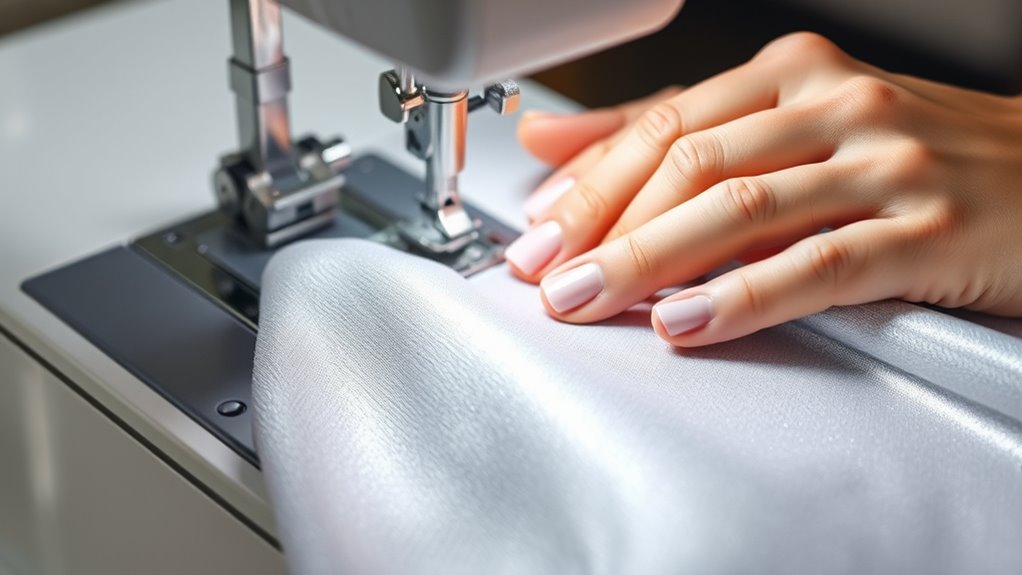To sew stretch fabrics without waves, choose the right fabric with appropriate stretch properties, and prepare your machine with a ballpoint needle designed for stretch materials. Use a stretch stitch or zigzag with a longer stitch length, and stabilize seams with lightweight interfacing or stabilizers. Be gentle when sewing, keep the fabric taut but not stretched too tight, and press seams carefully. Following these tips will help you achieve smooth, wave-free seams—more helpful details are ahead.
Key Takeaways
- Use a ballpoint or stretch-specific needle to prevent fabric snagging and puckering during sewing.
- Select a stretch stitch, zigzag, or narrow stitch with a longer stitch length (2.5–3.0 mm) for flexibility.
- Sew slowly with consistent tension, keeping fabric taut but not stretched to avoid wave formation.
- Finish seams with lightweight bias tape or serging to prevent bulk and maintain smoothness.
- Practice on scrap fabric to fine-tune tension, stitch settings, and handling before sewing the final piece.
Choosing the Right Stretch Fabric for Your Project
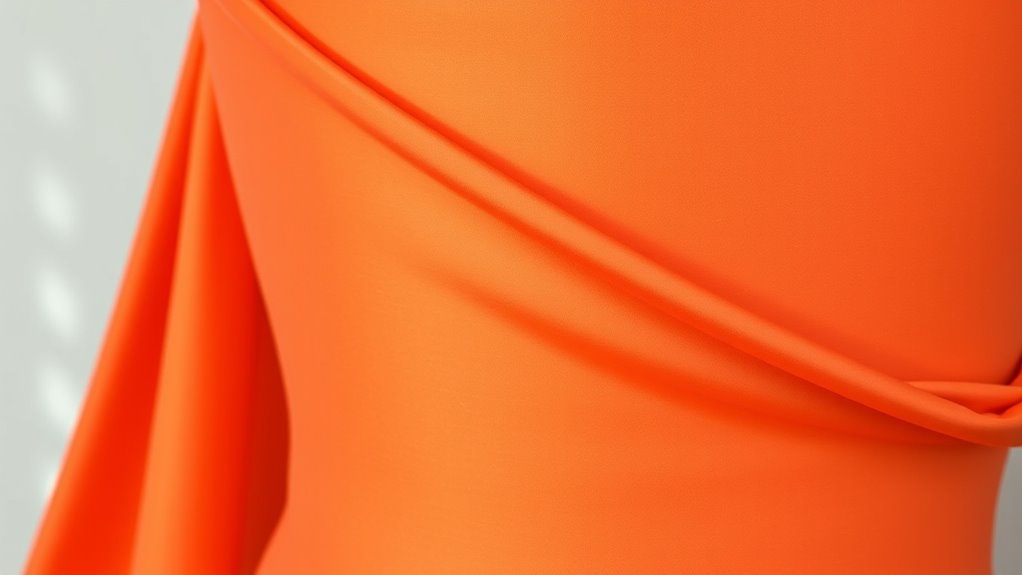
Choosing the right stretch fabric is essential for ensuring your project turns out as planned. You need to regard fabric stretchability, which varies depending on the textile composition. For example, fabrics with a high percentage of elastane or spandex offer more stretch and recovery, making them ideal for fitted garments. Conversely, fabrics made primarily of cotton or polyester have less stretch but provide stability. To select the best fabric, think about your project’s needs—whether you want a snug fit or a more relaxed silhouette. Check the textile composition carefully, as this influences stretchability, drape, and comfort. Understanding these factors helps you choose a fabric that performs well, maintains its shape, and results in a polished finished product. Additionally, considering water-related properties can be helpful when working with stretch fabrics for activewear or swimwear to ensure durability and comfort.
Preparing Your Sewing Machine and Tools

Before you start sewing stretch fabrics, make sure your machine is ready. Use a ballpoint needle designed for stretchy materials, and choose a thread that matches your fabric’s stretch. Don’t forget to adjust your machine settings to guarantee smooth, even stitches. Utilizing the right sewing tools can also improve the quality of your project and prevent fabric damage.
Use the Right Needle
Have you ever struggled with skipped stitches or uneven seams when sewing stretch fabrics? The right needle can make all the difference. Choose a needle with the correct size—usually a ballpoint or stretch needle in size 70/10 or 80/12—to prevent damaging the fabric fibers. The needle size affects stitch quality and fabric movement, so don’t go too large or small. Also, match your thread color to your fabric for a seamless look, but focus on using a high-quality thread suited for stretch fabrics. Proper needle selection guarantees smooth sewing and reduces skipped stitches. Keep your needle sharp and in good condition, and always change it after every few projects to maintain ideal stitching. Using the right needle is essential for flawless, wave-free seams. Additionally, selecting a needle that complements the fabric’s stretch qualities ensures better elasticity and durability in your finished project.
Select Appropriate Thread
Are you selecting the right thread for sewing stretch fabrics? Proper thread selection is crucial to prevent puckering and maintain flexibility. Use a polyester or nylon thread, as these have the stretch and durability needed for knit fabrics. When choosing thread, consider the stitch type you plan to use; a stretch stitch or zigzag works best for stretch fabrics because they allow movement without breaking. Avoid heavy or coarse threads that could create tension issues or waves. Matching the thread color to your fabric helps achieve a clean, professional look. Ensuring your thread is compatible with your machine and suited for stretch sewing sets the foundation for smooth stitching. Vetted options like polyester and nylon provide reliable performance for stretch fabrics. With the right thread and stitch type, you’ll create seams that stretch with your fabric without waviness or puckering.
Adjust Machine Settings
How can you guarantee your sewing machine is ready to handle stretch fabrics? Start by adjusting the machine settings to accommodate the fabric’s elasticity. Use a stretch stitch or a narrow zigzag to prevent wave formation. Set the tension correctly—too tight or too loose can cause puckering. Also, make certain your machine’s presser foot pressure isn’t too high, which can stretch the fabric unevenly. When working on projects like fabric dyeing or pattern drafting, these settings help achieve smooth seams. Be sure to test on scrap fabric first, checking for puckers or waves. Properly adjusting your machine’s tension, stitch type, and presser foot pressure makes all the difference in sewing stretch fabrics without waves.
Selecting the Appropriate Stitch Type and Length
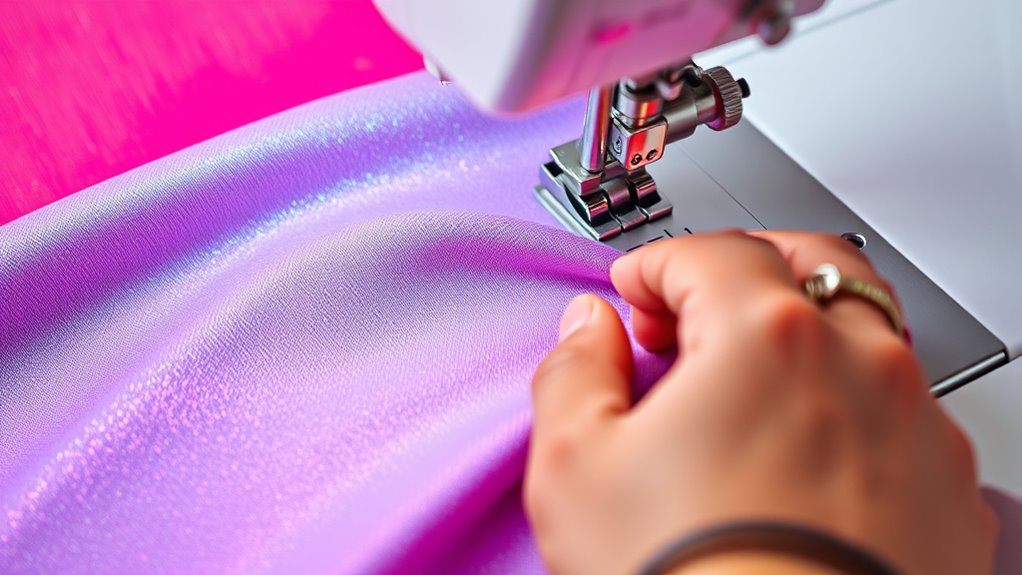
Choosing the right stitch type and length is essential for sewing stretch fabrics successfully. You want a stitch that maintains fabric stretch and preserves seam elasticity without causing puckering or waves. A stretch stitch, zigzag, or a narrow, stretch-friendly stretch sewing machine stitch works well. These stitches allow the fabric to expand and contract comfortably. When selecting stitch length, opt for a slightly longer setting than you typically use for woven fabrics; this helps prevent the stitches from breaking under tension. Generally, a stitch length of about 2.5 to 3.0 mm is ideal. Adjusting the stitch type and length ensures your seams remain flexible, durable, and free from waves, giving your project a professional, polished look.
Using a Ballpoint Needle for Stretch Fabrics
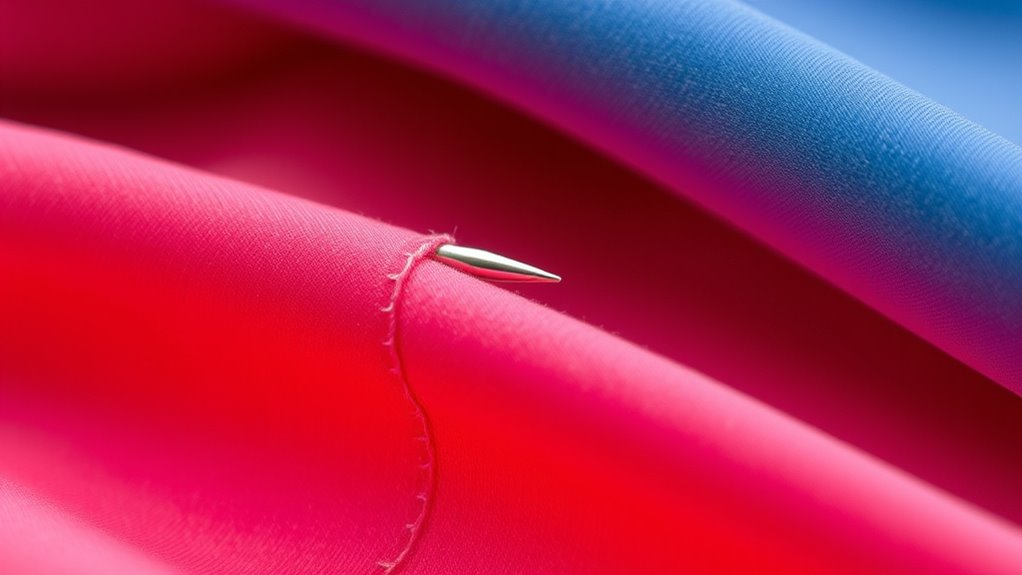
Using a ballpoint needle is essential when sewing stretch fabrics because its rounded tip helps avoid fabric puckering and damage. This design allows the needle to glide between the fibers without piercing them, maintaining seam flexibility. By choosing the right needle, you ensure smoother stitches and a professional finish on your stretchy projects.
Needle Tip Design
Have you ever noticed skipped stitches or puckering when sewing stretch fabrics? This often happens because the needle tip design impacts how the fabric elasticity is handled. A ballpoint needle’s rounded tip is specifically designed to glide between the fabric fibers, reducing the risk of damaging the material or causing skipped stitches. The needle’s shape also helps maintain needle sharpness longer, ensuring consistent penetration through the stretchy fabric. When selecting your needle, consider the influence of needle design on sewing performance and fabric care.
- The rounded tip minimizes fabric snags and puckering
- Proper needle alignment preserves fabric elasticity
- Using the correct needle tip prevents skipped stitches and maintains seam quality
Choosing the right needle tip design is essential for smooth sewing and professional results when working with stretch fabrics.
Fabric Puckering Prevention
To prevent fabric puckering when sewing stretch materials, selecting the right needle tip plays a crucial role. Using a ballpoint needle helps minimize fabric shifting and preserves the stretch fabric draping, ensuring smooth, even seams. The rounded tip gently pushes between fibers without piercing or damaging the fabric texture, which is especially important for delicate or finely textured stretch fabrics. When choosing your fabric, consider fabric texture selection—smooth, lightweight, or jersey-like textures respond best to a ballpoint needle, reducing puckering. This needle type maintains the fabric’s natural elasticity and movement, preventing tight stitches that cause waves or gathers. By matching the needle to your stretch fabric, you ensure a professional finish with clean, flat seams, and avoid the frustration of puckering during sewing.
Seam Flexibility Enhancement
A ballpoint needle considerably enhances seam flexibility when sewing stretch fabrics because its rounded tip allows stitches to move naturally with the fabric’s elasticity. This prevents puckering and maintains the fabric’s stretch ability, ensuring comfortable, durable seams. By choosing the right needle, you improve seam flexibility and reduce the risk of skipped stitches. To maximize these benefits, consider these points:
- Use a stretch or ballpoint needle specifically designed for fabric stretch.
- Adjust your sewing machine’s tension to accommodate the fabric’s elasticity.
- Opt for a zigzag or stretch stitch to allow seams to stretch without breaking.
- Selecting the appropriate sewing needle can further improve stitch quality and fabric compatibility.
Incorporating a ballpoint needle into your sewing process helps preserve the fabric’s stretch properties, creating professional-looking, flexible seams that last through wear and washing.
Employing Stabilizers and Interfacing Techniques

When sewing stretch fabrics, employing stabilizers and interfacing techniques is crucial to maintain shape and prevent puckering. Your first step is carefully selecting the right interfacing, considering its weight and stretch compatibility. Interfacing selection should match the fabric’s elasticity to avoid distortion. Use stabilizer types like tear-away, cut-away, or wash-away, depending on the project. Light stabilizers provide support without stiffness, while heavier ones add structure for hems or collars. Applying the stabilizer correctly—either fusible or sew-in—helps reduce shifting and stretching during sewing. Proper choice and placement of stabilizers and interfacing ensure your stretch fabric maintains its shape, giving you clean, professional results without waves or puckers. This technique is essential for achieving a smooth, polished finish on stretch garments.
Adjusting Tension and Presser Foot Pressure

Adjusting tension and presser foot pressure plays a vital role in achieving professional-looking stitches on stretch fabrics. Proper tension calibration guarantees stitches are even and prevent puckering or waviness. The presser foot should be adjusted so it holds the fabric securely without squeezing it too tightly, which can cause distortion. When working with stretchy materials, test sew on scrap fabric first to fine-tune your settings. Keep in mind that different fabrics may require different tension and presser foot adjustments. If stitches are wavering or fabric puckers, make small adjustments to either the tension or presser foot pressure. Regularly check your machine’s tension calibration and guarantee the presser foot is appropriate for your fabric type to get the best results. Additionally, using a proper needle type designed for stretch fabrics can improve stitch quality and fabric handling.
Techniques for Seam Finishing and Pressing

Effective seam finishing and pressing are essential steps to guarantee your stretch fabrics look polished and professional. When finishing seams, consider using lightweight bias tape or serging to prevent bulk and maintain stretch. Embroidery techniques, like decorative stitches, can add a unique touch while securing raw edges beautifully. Pressing should be done gently to avoid distorting the fabric, using a pressing cloth to protect the surface. When pressing seams open or to one side, apply light pressure and avoid excessive heat. Decorative stitches can also serve as decorative seam finishes, adding durability and visual appeal. Always press seams before sewing the final stitch to set the stitches and reduce puckering. Proper finishing and pressing techniques keep your stretch projects looking neat and durable. Additionally, understanding seam elasticity is crucial to preserve the fabric’s stretch and flexibility during pressing.
Tips for Cutting and Handling Stretch Materials
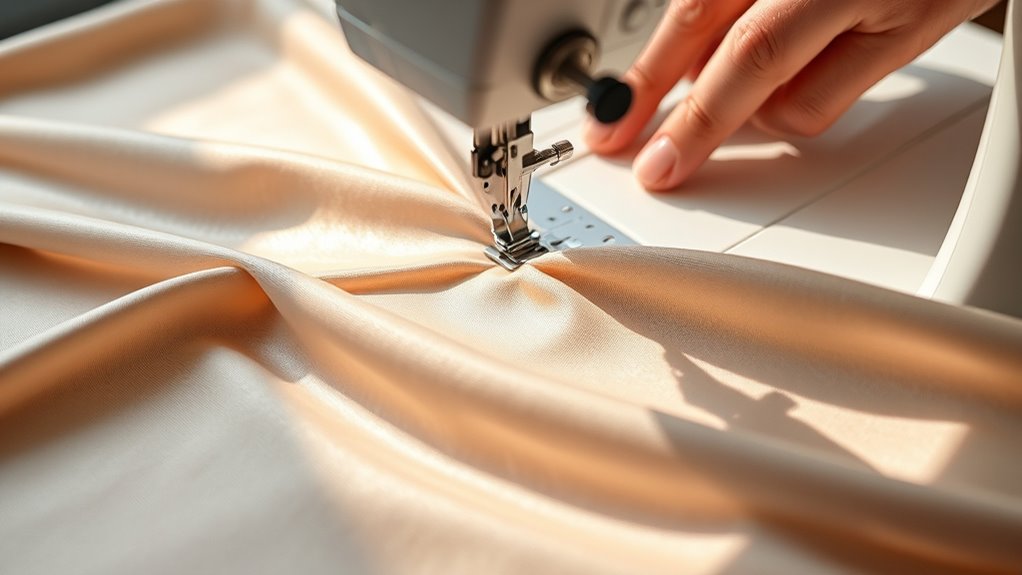
Handling stretch fabrics requires careful attention from the outset to prevent distortion and guarantee accurate cuts. To manage fabric stretchability, always use sharp scissors or rotary cutters, and cut on a flat surface. When pinning or marking, use fine pins or fabric chalk to avoid stretching the material. Pay close attention to pattern matching, especially at seams, ensuring stretch lines align properly. Keep the fabric taut but not overstretched during cutting to maintain its shape. Using specialized tools designed for stretch fabrics can further improve precision and ease of handling.
- Use pattern weights instead of pins to prevent shifting
- Cut slowly along pattern lines for precision
- Align grainlines carefully to match stretch directions
These tips help ensure clean cuts, proper pattern matching, and maintain the fabric’s integrity, making sewing stretch materials easier and more professional-looking.
Practicing on Scrap Fabric Before Sewing Your Main Piece
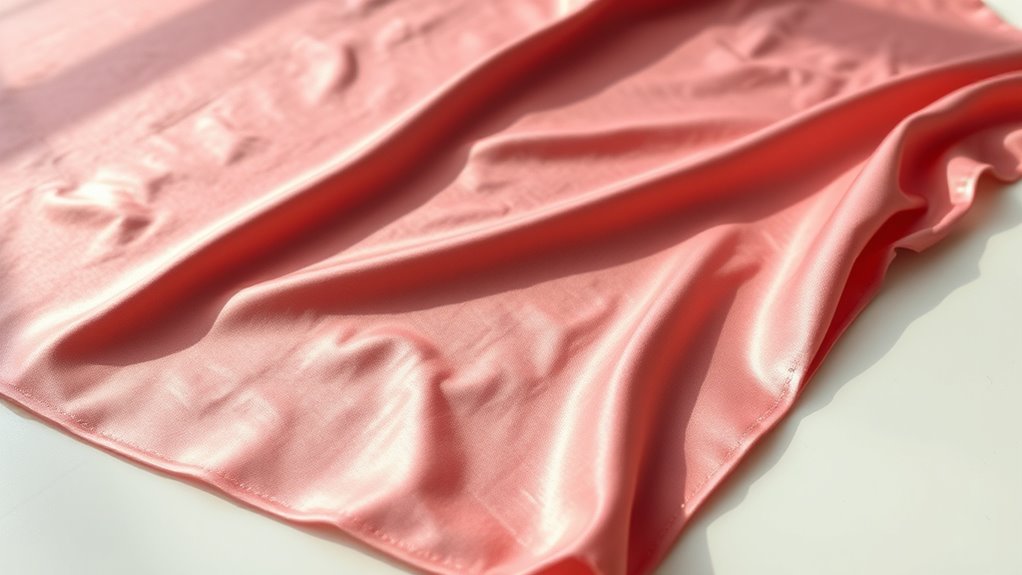
Before sewing your main piece, it’s smart to practice on scrap fabric. This allows you to test your stitching techniques and make any tension adjustments needed. Taking this step helps guarantee your final project comes out polished and professional. Using self-watering plant pots as a reference, consider that just as these planters maintain consistent moisture, practicing on scrap fabric ensures your stitches stay even and consistent throughout your project.
Test Stitching Techniques
Practicing your stitching techniques on scrap fabric is a crucial step before working on your main project. This helps you perfect your sewing techniques and guarantees your stitches can handle fabric stretch without causing waves or puckers. Test different stitch lengths, widths, and tension settings to see how they affect your fabric’s elasticity. Use scrap pieces that mimic your actual fabric to observe how it responds under various conditions. Pay attention to how your machine handles fabric stretch and make adjustments accordingly. Experiment with sewing techniques like zigzag or stretch stitches to find what works best. This practice reduces errors and gives you confidence, ensuring your final piece will have smooth seams and a professional finish. Additionally, understanding the importance of professional equipment can improve your results and comfort during sewing.
Adjust Tension Settings
Adjusting tension settings on your sewing machine is essential to achieving smooth, even stitches on stretch fabrics. Proper tension calibration helps accommodate the fabric’s stretch, preventing puckering or waviness. Before sewing your main piece, practice on scrap fabric with similar stretch properties. Test different tension settings to find the balance where stitches are secure but not tight or loose. If the stitches are puckering or the fabric pulls, loosen the tension; if the stitches are loose or skipped, tighten it. Remember, stretch fabrics require slightly different tension than woven fabrics. Take your time adjusting and testing until you get clean, consistent stitches. Understanding fabric properties can help you fine-tune your tension settings more effectively. This step guarantees your final project will have professional-looking seams without waves or puckers caused by incorrect tension.
Troubleshooting Common Issues and Achieving Flawless Seams

Troubleshooting common issues with sewing stretch fabrics is essential for achieving professional-looking seams. If your seams pucker or don’t hold, it often relates to fabric stretchability or insufficient seam durability. To fix these problems, check your tension settings and ensure your stitches are balanced. Using the right needle and thread designed for stretch fabrics also helps prevent skipped stitches. Additionally, consider the type of seam finish; flat-lock seams can improve flexibility and durability. Recognizing signs of high spiritual energy such as increased intuition and clarity can also inspire a more mindful sewing process, helping you stay present and attentive to your technique.
- Verify your tension and stitch length are appropriate for stretch fabrics
- Use stretch-specific needles and threads to enhance seam durability
- Test stitches on scrap fabric to identify issues before sewing your main project
Frequently Asked Questions
How Can I Prevent Puckering When Sewing Stretch Fabrics?
To prevent puckering when sewing stretch fabrics, start with fabric stabilization by applying stay tape or stabilizer along seam lines. Use a ballpoint or stretch needle, which easily penetrates the fabric without causing snags. Also, set your sewing machine to a stretch stitch or use a zigzag stitch to allow flexibility. These steps help keep the fabric smooth and prevent puckering, giving you clean, professional-looking results.
What Are the Best Thread Types for Stretch Sewing Projects?
The best threads for stretch sewing projects are those that can handle the incredible flexibility of fiber blends. Use polyester or nylon threads—they stretch with your fabric without breaking. Make certain your thread tension is just right; too tight, and it’ll snap, too loose, and it’ll sag. This perfect balance ensures smooth seams and prevents puckering or waves, giving your project professional, flawless results.
How Do I Sew Curved Seams Smoothly on Stretch Fabrics?
To sew curved seams smoothly on stretch fabrics, start by fabric stabilization with lightweight interfacing or stabilizer to prevent shifting. Use a stretch stitch or a narrow zigzag for flexibility. Sew slowly, keeping even tension, and pivot carefully at curves. Finish seams with serging or binding to prevent fraying. These seam finishing techniques help maintain shape and prevent waviness, ensuring professional-looking, smooth curved seams on your stretch fabrics.
Can I Use a Serger to Achieve Flat Seams on Stretch Materials?
Did you know that using a serger can reduce sewing time by up to 50%? Yes, you can achieve flat seams on stretch fabrics with a serger. Adjust the tension appropriately—tighten or loosen it depending on your fabric—and keep seam allowances narrow to prevent waviness. Properly setting your serger guarantees a smooth, professional finish, making sewing stretch materials faster and easier without waves or puckering.
What Storage Tips Help Maintain the Quality of Stretch Fabrics?
To keep your stretch fabrics in top condition, focus on proper fabric care and storage. Store them in breathable storage containers or fabric bins to prevent moisture and dust buildup. Avoid plastic bags that trap humidity, which can weaken the fibers. Keep your fabrics flat or rolled to prevent creases, and store in a cool, dry place away from direct sunlight. This will maintain their elasticity and quality over time.
Conclusion
Think of sewing stretch fabrics like tending a delicate garden—you need patience, the right tools, and gentle care. With the right choices and techniques, you’ll nurture beautiful, wave-free seams that flourish like vibrant blooms. Each stitch is a drop of water, each adjustment a gentle breeze guiding your project to perfection. Keep practicing, and soon you’ll be confidently tending your fabric garden, creating stunning pieces that grow more flawless with every sew.
